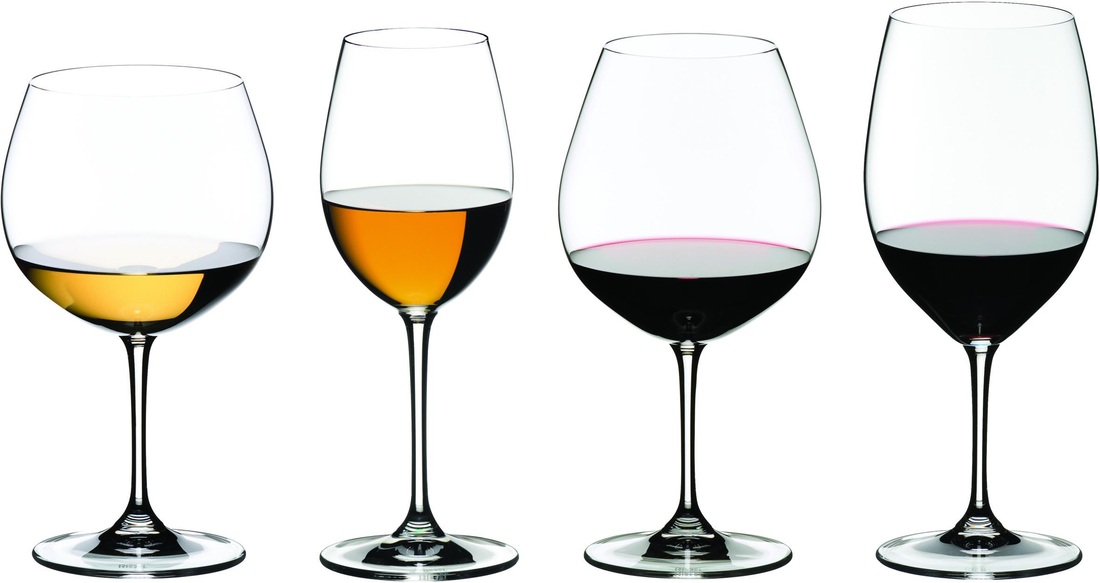n
a. Size: the glass should hold at least 14 ounces. Anything else is too small and probably best for shots of tequila or other medicinal purposes.
b. Clarity: the glass should be clear. No etched Viking mugs or sports commemorative cups from the local gas Station. Sight is a major aspect of our sensory enjoyment of wine. So your glass shouldn’t provide a visual experience reminiscent of an aquarium that hasn’t been cleaned out in six months.
c. Shape: the glass should be pear-shaped; the bottom of the bowl of the glass should be wider than the top. A pear-shaped bowl also helps to focus the aromas of the wine.
d. Material: the glass should be made of crystal. Why? Not just because it looks cool, but because crystal as a type of glass is very porous. When observed under a microscope, the surface of any crystal glass will be covered with pits and grooves. That means when you swirl the glass, the wine stays on the surface longer allowing all the aromatics to develop and lift into the atmosphere right into your nose.
e. Rim: the glass should have a thin cut rim. We’re getting technical here but stay with me. The rim is that tiny bit of the glass that not only comes into contact with your mouth, but also precisely directs how and where the wine will enter your mouth, specifically on your tongue–or palate as we say in the business. Believe it or not, that does make a difference in terms of how you physically perceive the structure of the wine, as in the tannins and acidity. Any irregularity in terms of the width or shape of the rim will change and even distort your perception of the wine. Sippy cups, anyone?
f. Height: the glass should NOT be overly tall: think large SUV’s with a high center of gravity. You get the idea, as in impending tragedy.
g. Price: don’t feel compelled to run out and purchase hideously expensive large hand-blown crystal glasses. While they may truly be works of art, they also bring a lot of maintenance with them. First, they’re a bit tough to handle table side. After all, your morning coffee cup probably doesn’t hold two pots–not cups–of coffee. Swirling one of these big rigs takes some practice. Second, they break without the slightest provocation as in breathing on them the wrong way. Third, they require the utmost in delicacy and control when washing and polishing (good luck with that one and be sure to read the last point in this blog entry).
Now you have all the information you need to purchase the right glassware. If interested, my favorite glass is the Riedel Vinum Sangiovese/Chianti Classico glass. I use it at home 90% of the time. It fits all the above criteria perfectly; it’s also a beautifully designed and elegant glass. Finally, in a perfect world you would five wine glasses, all made by Riedel (no, they aren’t paying me for writing this—but they probably should):
1. Bubbly: Vinum Champagne flute
2. White and light reds: Vinum Sangiovese/Chianti Classico glass
3. Pinot Noir and Burgundy: Vinum Pinot Noir glass
4. Full-bodied reds: Vinum Cabernet/Bordeaux glass
5. Dessert and fortified wines: Overture Red Wine glass
Parting Thoughts: Washing and Polishing Your Glasses.
Glassware should always be washed and polished the next day after use—when you’re SOBER. Trying to quickly work your way through several dozen glasses at the end of the night of a big dinner party is not only asking for trouble, it’s inviting bodily injury. I have a lovely scar on the first knuckle of my left pinky finger as evidence from the night I snapped the stem of a Champagne flute in half while polishing the glass, embedding part of it into said finger. A memorable trip to the emergency room followed. Remember: play hard, but play smart–and play safe. Cheers!
nn
